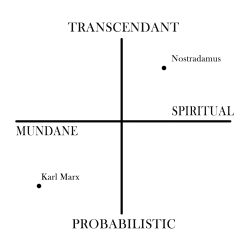Difference between revisions of "Prophecy"
m |
m (Text replacement - "Sharp (BOLIFE)" to "Sosteric (BOLIFE)") |
||
| Line 17: | Line 17: | ||
Nostradamus, a medieval priest, was confused by what he saw. As a result, his prophecies are confused and, consequently, useful only as a tool to confuse. | Nostradamus, a medieval priest, was confused by what he saw. As a result, his prophecies are confused and, consequently, useful only as a tool to confuse. | ||
As noted in | As noted in Sosteric (BOLIFE), there are two types of prophecy, probabilistic prophecy and transcendent prophecy. | ||
The full nature, and the mechanics of, prophecy are discussed in | The full nature, and the mechanics of, prophecy are discussed in Sosteric (BOLIFE). | ||
Revision as of 19:22, 22 August 2021
A Prophecy is simply a statement about the future occurrence of an event.
See Also
Transcendent Prophecy | Probabilistic Prophecy | Mundane Prophecy | Sacred Prophecy
Notes
Prophecies may be broken down on a four point axis.
A Prophet is an individual who claims to provide, or is widely regarded as providing, accurate/authoritative estimates as to the timing of ascension. Nostradamus is one individual regarded by many as a prophet.
Nostradamus, a medieval priest, was confused by what he saw. As a result, his prophecies are confused and, consequently, useful only as a tool to confuse.
As noted in Sosteric (BOLIFE), there are two types of prophecy, probabilistic prophecy and transcendent prophecy.
The full nature, and the mechanics of, prophecy are discussed in Sosteric (BOLIFE).
